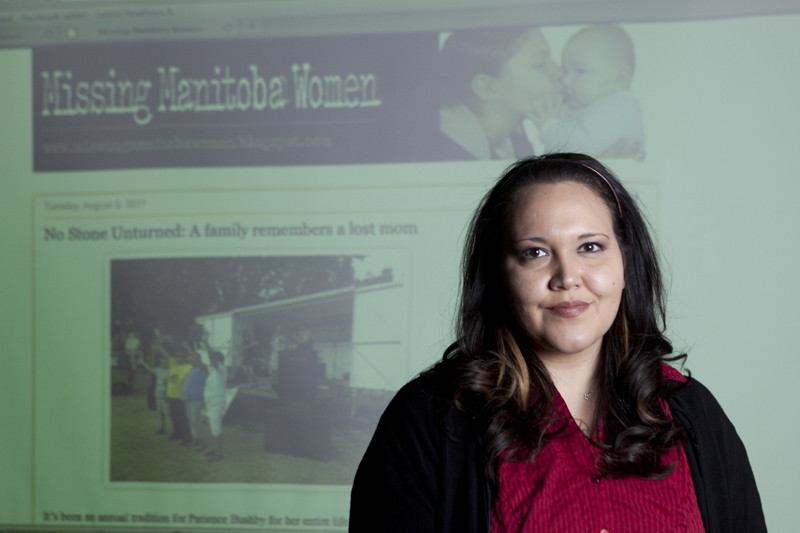Shelley Cook's frustration with the way that she saw Winnipeg's mainstream media portraying missing aboriginal women came to a boiling point in the winter of 2004.
 |
| Shelley Cook |
parking lot in Grand Forks, North Dakota, and the case garnered massive amounts of media
attention in Winnipeg. A few months later, on February 20, 2004, sixteen year old Sunshine Wood, a Manitoba girl of aboriginal descent, went missing from the St. Regis Hotel in Winnipeg, but Cook noticed that the Wood case was not getting anywhere near the same kind of attention in Winnipeg that the Sjodin case was getting.
 |
| Sunshine Wood |
“Her case was barely covered,” said Cook, “Dru was still missing at this time and her case was getting far more attention in Winnipeg than a teenager in Manitoba who vanished from our own city. I remember being mad, but at that time of my life I didn't think I could actually do anything other than be outraged.”
Cook also believed that the media in Winnipeg stereotyped missing aboriginal women. “I can't stand the fact that many of Manitoba's missing women are portrayed the way that they are. Clearly you can't ignore the elephant in the room that some of these women lived high risk lifestyles, but a person's lifestyle, race, and living conditions shouldn't matter.”
So in 2009, when Cook was assigned an Independent Professional Project (IPP) as part of the Creative Communications program at Red River College in Winnipeg, she finally saw the opportunity to do something about her frustration. “Originally I wanted to write a book that featured the stories of three or four missing aboriginal women. I wanted to highlight these women as human beings, showing them as people, not as troubled women or sex trade workers.”

She pitched her idea to a panel of Creative Communications instructors, and although they liked the concept, they thought it should be presented in a different medium. “They liked it, except they didn't think a book fit the project. To them a blog made more sense, because the stories are not finished. At that time I never imagined my project would become what it is today.”
What her project became was the Missing Manitoba Women blog, a site that tells the stories of Manitoba's missing and murdered women, the same stories that Cook believes are ignored by mainstream media in Winnipeg.

In 2010 the Native Women's Association of Canada (NWAC) reported in a fact sheet entitled Missing and Murdered Aboriginal Women and Girls in Manitoba that “Manitoba has the third highest number of cases in Canada.” NWAC reported that in 2010 there were 79 cases of missing or murdered aboriginal women in the province of Manitoba.
Cook realized that for many family members of missing women, her blog provided the only place where they could tell the story of their loved ones. “People want to talk. Many of the people I have spoken to have never really been given the opportunity to speak out. Don't get me wrong, I've had to earn the trust of these families, but since I've started my online work I have come to know many of the people in the community.”
One of the people she has become friends with through the blog is Matt Bushby, the fiancé of Claudette Osborne-Tyo, who went missing from Winnipeg's North End on July 24, 2008 and has never been found.
 |
| Claudette Osborne-Tyo and Matt Bushby |
He feels the Missing Manitoba Women blog is the only place where he can tell the real story of his fiancé. “I wanted to tell Claudette's story for years, but I don't have good writing ability so when I was able to tell Shelley the story, and then have it told on her blog, it was a good feeling,” said Bushby, “Shelley was the only one who made me feel comfortable. Claudette had some problems, but that's all the rest of the media ever focused on. She was a loving mother and fiancé, but that kind of story doesn't sell papers does it? People want dirty laundry.”
At this point, Bushby is just looking for closure. “I'm not thinking she's going to walk in the door tomorrow, but I just want to know what happened for the sake of her children.”
Cook's blog has let families of missing women have the stories of their loved ones told, but she is still humble when asked about the difference she has made in people's lives. “I feel like I get too much credit. It's all grassroots. Anyone can do this. Anyone.”
To check out the Missing Manitoba Women blog visit www.missingmanitobawomen.blogspot.com



